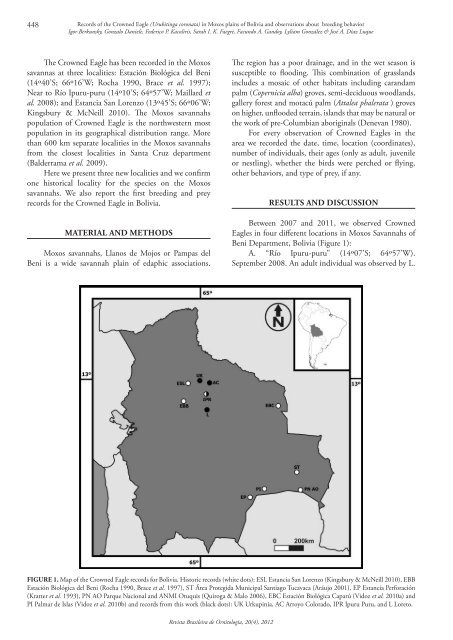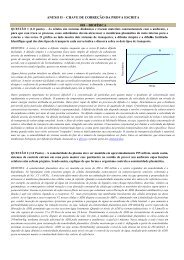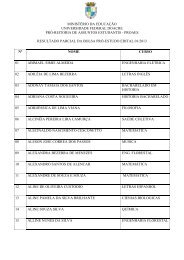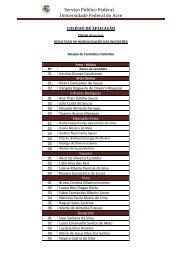Revista Brasileira de Ornitologia - Universidade Federal do Acre
Revista Brasileira de Ornitologia - Universidade Federal do Acre
Revista Brasileira de Ornitologia - Universidade Federal do Acre
You also want an ePaper? Increase the reach of your titles
YUMPU automatically turns print PDFs into web optimized ePapers that Google loves.
448Records of the Crowned Eagle (Urubitinga coronata) in Moxos plains of Bolivia and observations about breeding behaviorIgor Berkunsky, Gonzalo Daniele, Fe<strong>de</strong>rico P. Kacoliris, Sarah I. K. Faegre, Facun<strong>do</strong> A. Gan<strong>do</strong>y, Lyliam González & José A. Díaz LuqueThe Crowned Eagle has been recor<strong>de</strong>d in the Moxossavannas at three localities: Estación Biológica <strong>de</strong>l Beni(14º40’S; 66º16’W; Rocha 1990, Brace et al. 1997);Near to Río Ipuru-puru (14º10’S; 64º57’W; Maillard etal. 2008); and Estancia San Lorenzo (13º45’S; 66º06’W;Kingsbury & McNeill 2010). The Moxos savannahspopulation of Crowned Eagle is the northwestern mostpopulation in its geographical distribution range. Morethan 600 km separate localities in the Moxos savannahsfrom the closest localities in Santa Cruz <strong>de</strong>partment(Bal<strong>de</strong>rrama et al. 2009).Here we present three new localities and we confirmone historical locality for the species on the Moxossavannahs. We also report the first breeding and preyrecords for the Crowned Eagle in Bolivia.MATERIAL AND METHODSMoxos savannahs, Llanos <strong>de</strong> Mojos or Pampas <strong>de</strong>lBeni is a wi<strong>de</strong> savannah plain of edaphic associations.The region has a poor drainage, and in the wet season issusceptible to flooding. This combination of grasslandsinclu<strong>de</strong>s a mosaic of other habitats including carandampalm (Copernicia alba) groves, semi-<strong>de</strong>ciduous woodlands,gallery forest and motacú palm (Attalea phalerata ) groveson higher, unfloo<strong>de</strong>d terrain, islands that may be natural orthe work of pre-Columbian aboriginals (Denevan 1980).For every observation of Crowned Eagles in thearea we recor<strong>de</strong>d the date, time, location (coordinates),number of individuals, their ages (only as adult, juvenileor nestling), whether the birds were perched or flying,other behaviors, and type of prey, if any.RESULTS AND DISCUSSIONBetween 2007 and 2011, we observed CrownedEagles in four different locations in Moxos Savannahs ofBeni Department, Bolivia (Figure 1):A. “Río Ipuru-puru” (14º07’S; 64º57’W).September 2008. An adult individual was observed by L.FIGURE 1. Map of the Crowned Eagle records for Bolivia. Historic records (white <strong>do</strong>ts): ESL Estancia San Lorenzo (Kingsbury & McNeill 2010), EBBEstación Biológica <strong>de</strong>l Beni (Rocha 1990, Brace et al. 1997), ST Área Protegida Municipal Santiago Tucavaca (Aráujo 2001), EP Estancia Perforación(Kratter et al. 1993), PN AO Parque Nacional and ANMI Otuquis (Quiroga & Malo 2006), EBC Estación Biológica Caparú (Vi<strong>do</strong>z et al. 2010a) andPI Palmar <strong>de</strong> Islas (Vi<strong>do</strong>z et al. 2010b) and records from this work (black <strong>do</strong>ts): UK Urkupinia, AC Arroyo Colora<strong>do</strong>, IPR Ipuru Puru, and L Loreto.<strong>Revista</strong> <strong>Brasileira</strong> <strong>de</strong> <strong>Ornitologia</strong>, 20(4), 2012










